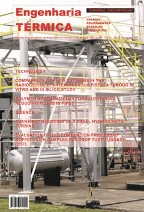| Vol.
14 - No. 2 December 2015 ISSN 1676-1790 |

| AOS AUTORES FOR AUTHORS |
| EDITORIAL EDITORIAL |
| EXPEDIENTE STAFF |
| ENTRE EM CONTATO GET IN TOUCH |
| HOME |
É necessário
o software Adobe Acrobat Reader ou Foxit Reader para a visualização
do material pois os artigos apresentados estão no formato
PDF. Clique aqui para download do Adobe |
| Parceiros |





| Editorial |
|
O editorial de Engenharia Térmica deste número continua a discussão sobre as necessidades de pesquisa científica em áreas vitais em que a engenharia térmica tem participação destacada. O objetivo principal é o de motivar os leitores, dentro de suas especialidades, a identificar possíveis assuntos para sua pesquisa futura. O avanço mais significativo da Biologia Molecular nos últimos anos foi decorrente do desenvolvimento da técnica que permitiu a multiplicação ilimitada de moléculas de DNA (ácido desoxirribonucleico – material genético da maioria dos seres vivos). Denominada de PCR (Polimerase Chain Reaction), esta técnica proporcionou o avanço de diversas áreas científicas. O diagnóstico rápido e preciso de doenças por PCR permitiu uma maior eficácia no tratamento destas doenças. O grau de confiabilidade desta técnica é tão grande, que a identificação de um criminoso por PCR é aceita como prova forense. Para que uma reação de PCR ocorra, são necessários a molécula de DNA que servirá de molde, uma enzima chamada DNA polimerase e nucleotídeos, que comporão a nova fita de DNA. De uma forma simplificada, estes são os ingredientes principais, mas somente misturá-los em um tubo de ensaio não é suficiente para desencadear o processo de amplificação do DNA. Para isto, devem ocorrer variações cíclicas de temperatura, podendo ser: uma desnaturação inicial do DNA a 94o C por 2 min; 35 ciclos de 1 min a 94o C, 1 min a 62o C, 1 min a 72o C e uma extensão final por 4 min a 72o C. Para que estas trocas cíclicas de temperatura ocorram com exatidão, foi desenvolvido em equipamento chamado termociclador. Ou seja, esta técnica revolucionária associa reações enzimáticas e um processo termodinâmico. Atualmente a maioria dos termocicladores utiliza a tecnologia Peltier, explorando as propriedades dos semicondutores e oferecendo uma maior uniformidade nas diferentes temperaturas e consequentemente resultados com alto grau de precisão e reprodutibilidade. Desta forma aproveito a oportunidade para incentivar pesquisas na área de Engenharia Térmica em interface com a área de Biologia Molecular, que, conforme foi exposto acima, poderão contribuir para grandes avanços científicos na área biológica e uma melhoria na qualidade de vida da comunidade em geral. A missão de Engenharia Térmica é a de documentar o progresso científico em áreas relacionadas à engenharia térmica (e.g., energia, petróleo, combustíveis renováveis, biotecnologia). Nós estamos confiantes que continuaremos a receber submissões de artigos que contribuam para o progresso da ciência. Vanessa Kava, D.Sc. |
| Editorial |
|
The editorial of Engenharia Térmica of this issue continues the discussion on scientific research needs in vital areas in which thermal engineering has important participation. The main goal is to motivate the readers, within their specialties, to identify possible subjects for their future research. The most significant advance in Molecular Biology area in recent years was due to the development of a technic that provides the unlimited multiplication of DNA molecules (deoxyribonucleic acid – genetic material of most living things). Named PCR (Polymerase Chain Reaction), this technique afforded the progress of several scientific areas. The rapid and accurate diagnosis of diseases by PCR allows for greater effectiveness in the treatment of these diseases. The reliability of this technique is so great, that the identification of a criminal by PCR is accepted as forensic evidence. To perform a PCR reaction, it is necessary a DNA molecule to serve as a template, an enzyme called DNA polymerase and nucleotides, which make up the new DNA strand. In a simplified way, these are the main ingredients, but only mixing them in a test tube is not sufficient to trigger the process of DNA amplification. For this, cyclic temperature variations must occur, such as: a DNA initial denaturation at 94o C for 2 min, 35 cycles of 1 min at 94o C, 1 min at 62o C, 1 min at 72o C, and a final extension for 4 min at 72o C. For the accurate occurrence of these cyclic temperature changes, an equipment called thermocycler was developed. In other words, this revolutionary technique combines enzymatic reactions and a thermodynamic process. Currently most thermocyclers use the Peltier technology, exploiting the properties of semiconductors and providing greater uniformity at different temperatures that result in a high degree of accuracy and reproducibility. Thus, I take the opportunity to encourage research in the field of Thermal Engineering interfaced with Molecular Biology, which, as discussed above, may contribute to major scientific advances in biological sciences, and an improvement in the community's quality of life in general. The mission of Engenharia Térmica is to document the scientific progress in areas related to thermal engineering (e.g., energy, oil and renewable fuels, biotechnology). We are confident that we will continue to receive articles’ submissions that contribute to the progress of science. Vanessa Kava, D.Sc. |
Autores/Authors | Editorial/Editorial | Contatos/Get in Touch | Expediente/Staff
Outras edições:
Vol.1 - nº1 (antes Nº1),
Vol.1 - nº2 (antes Nº2),
Vol.1 - nº1 (antes Nº3),
Vol.1 - nº1 (antes Nº4),
Vol.3 - nº1,
Vol.3 - nº2,
Vol.4 - nº1,
Vol.4 - nº2,
Vol.5 - nº1,
Vol.5 - nº2,
Vol.6 - nº1,
Vol.6 - nº2,
Vol.7 - nº1,
Vol.7 - nº2,
Vol.8 - nº1,
Vol.8 - nº2,
Vol.9 - nº1-2,
Vol.10 - nº1-2,
Vol.11 - nº1-2,
Vol.12 - nº1,
Vol.12 - nº2,
Vol.13 - nº1,
Vol.13 - nº2,
Vol.14 - nº1.
Copyright © 2003-2015
Todos os direitos reservados